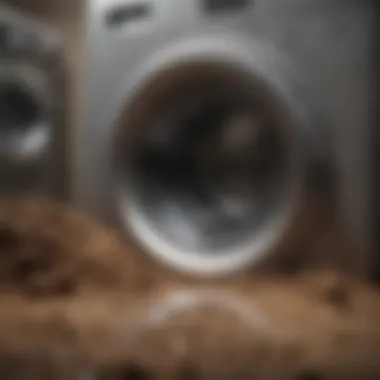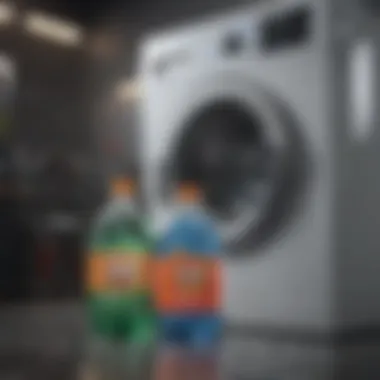Essential Steps to Clean Your Dirty Washer


Intro
Cleaning a washing machine is a task that often goes overlooked. Many people assume that because washing machines clean clothes, they do not require regular maintenance themselves. However, neglecting this chore can lead to unpleasant odors, mold growth, and diminished cleaning efficiency. Understanding how to properly clean your washer is essential for keeping your appliance running optimally. In this guide, we will explore various techniques, both natural and commercial, to ensure your washing machine remains spotless and effective.
Throughout this article, key topics will include the importance of cleaning the washer, specific areas that need attention, step-by-step instructions for various cleaning methods, and tips to prevent future buildup. By focusing on these aspects, homeowners will equip themselves with practical knowledge to maintain their washing machines without hassle.
Understanding the Importance of a Clean Washer
Keeping a washing machine clean is often overlooked, yet it plays a crucial role in overall appliance maintenance. A dirty washer can lead to several negative effects on both laundry outcomes and the appliance's longevity. Understanding these implications will aid homeowners in realizing the importance of regular cleaning.
Impact on Laundry Quality
A clean washer directly correlates to the cleanliness of laundry. When dirt and mold accumulate inside, they transfer to clothes, resulting in less than satisfactory cleaning. Detergents may not be as effective when residues build up. This can cause lingering odors and unclean clothes, defeating the purpose of washing. Inconsistent washing results can frustrate users and drive them to consider purchasing a new machine sooner than necessary. Therefore, maintaining a clean washer ensures that clothing looks fresh and smells pleasant after every wash.
Prolonging Washer Lifespan
Regular cleaning is fundamental for extending the lifespan of a washing machine. Just like any appliance, neglecting maintenance can lead to premature wear and tear. Dirt and grime can clog internal components and lead to mechanical issues. For example, mineral deposits may build up in hoses and pipes, causing blockages. Cleaning the machine routinely reduces the strain on these systems and can prevent costly repairs or the need for a replacement. Investing time in cleaning ensures that the machine continues to function effectively for years.
Health Concerns Related to Mold
Another key reason for keeping a washer clean is to address health concerns related to mold. Washing machines can create a damp environment where mold thrives, especially in high-efficiency models that use less water. Mold can pose serious health risks, including allergies and respiratory issues. Users may not even realize that their washer is a breeding ground for these harmful spores. Regularly cleaning the washer eliminates this concern, promoting a healthier home environment. Ultimately, a clean washer is not merely about machine functionality; it is also about safeguarding the health of those who use it.
"A well-maintained washing machine is essential not just for performance, but for health and safety."
By appreciating the importance of cleanliness, users can take actionable steps to ensure their washing machines operate efficiently and safely.
Identifying Dirty Washers
Cleaning a washer is necessary for its longevity and effectiveness. However, many people overlook the signs that indicate their appliance is dirty. Identifying these signs early is vital. Doing so can prevent more costly repairs down the line. It also ensures that your laundry comes out clean and fresh.
Signs of Accumulated Dirt
Dirt build-up in a washing machine may not always be immediately visible. Nonetheless, some signs can indicate accumulated dirt. One of the most common signs is discoloration around the door seal or inside the drum. This might suggest that residue from detergent or fabric softener has accumulated over time. Further, if you notice lint or dust in places that are usually overlooked, that can be another telling sign.
Here are more specific signs to watch for:
- Stains inside the drum: Discolorations can be a warning that dirt is present.
- Excessive suds in the machine: This can indicate a build-up of detergent residue.
- Black or brown specks: These might be mold or mildew, which require immediate attention.
Common Odors Indicating Problems
An unpleasant odor emanating from your washer should not be ignored. If your washing machine smells musty or sour, this is an indication of a deeper problem. Typically, these odors are caused by mold or mildew developing in damp areas like the rubber seals or under the drum.
Common smells to note include:
- Mildew odor: Often a sign of water getting trapped in the washer.
- Chemical smell: This could indicate a build-up of cleaning products.
- Rotting smell: This could be from items that were left in the washer too long.
Visual Indicators of Mold Growth


Mold can grow quickly if the washer is not cleaned regularly. Furthermore, mold can have serious health implications. It is crucial to identify any visual indicators of mold growth as soon as possible. Check the rubber gaskets around the door. This area is often overlooked and can trap moisture, resulting in mold growth.
Signs of mold include:
- Black or green spots on rubber seals or inside the drum.
- Fuzzy texture around these areas, which suggests mold colonies.
- Discoloration of the interior surfaces. If you notice any of these signs, cleaning should become a priority.
Identifying a dirty washer is the first step toward maintaining it effectively. Ignoring the signs can lead to laundry issues and health concerns.
Preparing for the Cleaning Process
Preparing for the cleaning process is a pivotal step in ensuring your washing machine is not only cleaned effectively but also that the task is performed safely. This phase lays the groundwork for efficient cleaning by allowing you to gather all necessary items and understand the precautions to take. Without proper preparation, efforts to clean may be hindered due to a lack of supplies or improper handling of the machine. Therefore, it is essential to take this step seriously.
Gathering Necessary Supplies
Cleaning Solutions
Cleaning solutions play an important role in the cleaning procedure. They effectively break down dirt, grime, and any residues that may be left over from laundry. There are various cleaning solutions available, including natural options like vinegar and baking soda, as well as commercial products specifically designed for washers.
The key characteristic of cleaning solutions is their ability to target specific types of buildup. For instance, vinegar is known for its deodorizing properties, while some commercial products include enzymes that digest organic materials. This diversity provides you with choices based on personal preference and effectiveness.
A unique feature of these solutions is their form - some are powders, while others are liquids. The advantages of liquid solutions are ease of application, while powders may provide more concentrated results. It is crucial to choose the right solution according to your washer’s material and specific needs.
Tools Required
In addition to cleaning solutions, you need the right tools to clean your washer. Commonly used tools include microfiber cloths, sponges, and a soft brush. The key characteristic of effective tools is their ability to reach all areas of the washer without damaging surfaces.
Using appropriate tools ensures that you thoroughly clean areas that are often neglected, such as seals and corners of the drum. The unique feature of microfiber cloths is that they can absorb more moisture and dirt compared to standard cloths. This characteristic makes them highly beneficial for cleaning without scratching the surfaces.
Protective Gear
Protective gear is often overlooked but is essential for safety during the cleaning process. Wearing gloves, goggles, and a mask can protect you from exposure to harsh chemicals in some cleaning solutions. The key characteristic of protective gear is its ability to ensure your safety while handling cleaning materials.
Using gloves can help prevent skin irritation, especially for those with sensitive skin. The unique feature of goggles and masks is their protection against splashes and inhalation of fumes. These precautions may seem trivial, but they are significant in ensuring a safe cleaning experience.
Disconnecting Power and Water
Before starting any cleaning task, one must disconnect both the power supply and water supply to the washer. This step is vital. It protects you from electrical hazards and prevents water spillage during your cleaning process. Always ensure that the machine is in a safe state before moving forward with the cleaning.
Cleaning the Interior of the Washer
Cleaning the interior of your washing machine plays a crucial role in maintaining its overall function and prolonging its lifespan. When dirt, detergent residue, and other contaminants accumulate in the drum and components, they can affect washing performance. This can lead to inadequate cleaning of laundry and the unpleasant odors that often accompany a neglected appliance. Regular cleaning helps ensure that your washer can operate efficiently, thus reducing wear and the likelihood of breakdowns.
Using Vinegar and Baking Soda
Vinegar and baking soda are not only common household staples but also effective cleaning agents for a dirty washer. To utilize this method, begin by pouring two cups of white vinegar into the drum of the empty washer. Select a hot water cycle and run the washer. The vinegar will help to dissolve any buildup of detergent residue and mineral deposits.
After the vinegar cycle is complete, sprinkle a half cup of baking soda into the drum. Run another hot cycle. This step will further combat any remaining odors and provide an additional cleansing action.
Regular use of this method can keep your washing machine smelling fresh and looking clean without the use of harsh chemicals.


Utilizing Commercial Cleaning Products
If you prefer to use commercial products, there are several options available specifically designed for cleaning washing machines. Brands like Affresh and Tide offer cleaning tablets that target residues and grime. To use these products, simply follow the manufacturer's instructions. This typically involves placing a tablet in the drum or the detergent compartment and running a dedicated cleaning cycle.
When choosing a commercial cleaner, ensure it is compatible with your washer type. These products are formulated for deep cleaning and can often tackle stubborn stains and odors that vinegar and baking soda may not fully address.
Wiping Down Seals and Gaskets
The seals and gaskets of your washing machine are essential for preventing leaks. However, they also often trap moisture, lint, and dirt. To clean these areas, use a damp cloth or sponge. It’s important to ensure that you are thorough in this task, as build-up in these crevices can lead to mold development or unpleasant smells.
Consider using a solution of warm water and mild detergent for cleaning. Make sure to get into all the folds and grooves of the rubber. After cleaning, wipe down the seals with a dry cloth to prevent moisture accumulation.
Cleaning the Detergent Dispenser
The detergent dispenser can also become a site for buildup and should be cleaned regularly. Begin by removing the dispenser tray if your model allows it. Rinse it under warm water to loosen any detergent residue. A soft bristle brush can be useful for scrubbing away stubborn deposits.
In cases where the dispenser cannot be removed, use a cloth soaked in a warm water solution to wipe it down. Ensure there are no clogged openings to allow for proper detergent flow during wash cycles. This preventative measure ensures that your laundry can be cleaned effectively without any interference from product buildup.
Cleaning the Exterior of the Washer
Keeping the exterior of a washing machine clean is significant for several reasons. First, a clean surface reflects the general cleanliness of your laundry environment. It also prevents dust and grime from building up, which can lead not just to aesthetic issues but also to problems functioning effectively. Regular cleaning helps maintain the longevity of the appliance, as dirt build-up can lead to corrosion over time. Additionally, it can improve the efficiency of the unit and may even reduce energy costs. Paying attention to the exterior means one also acknowledges the care and maintenance required for functional appliances.
Wiping Down Surfaces
Wiping down the surfaces of your washer is a simple yet effective way to maintain its appearance and function. To start this process, gather some soft cloths or microfiber towels and an appropriate cleaner. A mixture of warm water and mild detergent is often enough to remove everyday grime. Alternatively, specific appliance cleaners are available in stores.
To clean the surfaces, first dampen your cloth with the chosen cleaning solution. Gently wipe the top, sides, and control panel of the washer. Be careful not to oversaturate the cloth, as excess water can seep into electronic components and cause damage. You should also ensure to wipe in the direction of any grain patterns, especially when cleaning surfaces that are stainless steel. This helps avoid streaks and leaves a more polished appearance.
For areas that tend to gather dust or spills, such as around the dispenser or knobs, consider dedicating some time for thorough cleaning. Regularly wiping down these areas prevents the build-up of sticky residues and enhances overall hygiene. Don’t forget to check behind the washer as well; it's common for dust and lint to accumulate there, and it can be overlooked during routine cleaning.
Polishing Stainless Steel Finishes
When dealing with stainless steel finishes, it is important to use the right products to maintain their shine. Stainless steel can show fingerprints and watermarks quite easily, adding to the visual clutter. In this case, you will want to use a cleaner specifically formulated for stainless steel.
After cleaning the surface with a damp cloth, apply a small amount of polish to another soft cloth. Work the polish into the surface in a circular motion. This will not only remove streaks but also create a protective barrier against further smudging.
The use of stainless steel cleaner optimizes the appearance and can extend the life of the finish by preventing corrosion. Most importantly, it preserves the aesthetics of your appliance, making it an integral part of creating a polished look in your laundry area.
"A well-maintained washer reflects a homeowner's commitment to cleanliness and care.
Maintaining a Clean Washer
Maintaining a clean washer is not just related to aesthetics; it has direct implications on the machine's performance and longevity. A well-maintained washer results in cleaner laundry, greater energy efficiency, and a healthier environment in your home. Over time, neglecting this aspect can lead to significant issues, including mold growth and diminished washing power, both of which can result in costly repairs and replacements.
Regular cleaning habits will not only keep your washer running smoothly but can also extend its lifespan. A washer that is regularly cleaned requires less energy to operate efficiently, which can lead to savings on your utility bills. Additionally, this reduces the risk of mechanical problems that could arise from clogged filters or residual detergent buildup.
Setting a Cleaning Schedule


Establishing a regular cleaning schedule is essential. Aim for a thorough cleaning once a month, but this can vary depending on usage. If your washer is used frequently or you do large batches of laundry, consider cleaning it bi-weekly. Include the cleaning schedule in your monthly household chores.
A sample of what a cleaning schedule might look like:
- Monthly: Deep clean washer with vinegar and baking soda.
- Bi-weekly: Wipe down seals and dispensers.
- Weekly: Quick wipe of exterior surfaces.
- After heavy use: Inspect for odors or dirt.
Using reminders on your phone or a family calendar can help ensure that these tasks are not overlooked.
Best Practices for Usage
In addition to a cleaning schedule, implementing best practices during laundry is crucial. Always use the right amount of detergent for your load size to avoid residue buildup. Overloading the washer can also contribute to dirt accumulation since detergent cannot circulate properly.
Here are some best practices:
- Measure detergent accurately. Too much detergent can lead to excess foam, making it harder to rinse out.
- Leave the door open after cycles. This allows air circulation, which helps prevent mold and mildew.
- Use high-efficiency detergents. These are formulated to clean well without excessive suds.
Tips for Preventing Future Buildup
Preventing future buildup is the best approach to washer maintenance. Identifying small habits that can curb buildup is essential for maintaining cleanliness in the long run. Here are some practical tips to consider:
- Rinse seal with warm water. Just as you would wipe down surfaces, rinsing out seals removes hidden debris.
- Use a washer cleaner. A monthly application of a commercial washer cleaner can effectively prevent mold and grime.
- Check for clogs. Regularly inspect and clean filters and hoses to remove lint or mineral deposits.
Regular maintenance not only extends the life of your washing machine but also ensures that every cleaning cycle yields the best results.
In summary, maintaining a clean washer is an outright necessity for efficiency and longevity. By setting a cleaning schedule, following best usage practices, and implementing preventative measures, you can keep your washer functioning optimally for many years to come.
When to Call a Professional
Maintaining a washing machine in optimal condition is essential for both performance and longevity. However, there are scenarios when homeowners should not attempt to handle the situation themselves. Recognizing when to call a professional can save one from further damage or more expensive repairs. This section discusses the key factors to consider when determining whether professional assistance is necessary.
Identifying Mechanical Issues
Some washer problems may not be solvable through standard cleaning methods. If you notice unusual noises, failure to spin, or error codes on the display, these could indicate underlying mechanical issues. A disassembling or reassembling of internal components may be needed. In such cases, calling a qualified technician makes sense. Service professionals have the expertise to diagnose the precise issue and provide solutions swiftly.
Using a pro can alleviate stress. You avoid the risk of misdiagnosing the problem, which can lead to additional costs down the line. Plus, they usually provide warranties on repairs, ensuring peace of mind. To summarize, if mechanical issues arise, seeking professional help is often the best course.
Determining Severity of Mold Infestation
Mold growth inside washing machines not only poses health risks but also affects appliance efficiency. If you discover mold or mildew and it seems excessive, consider consulting a professional cleaner. They have access to specialized products and equipment that can effectively tackle significant mold problems.
A technician can inspect areas usually overlooked, like hoses and internal components. A thorough assessment and treatment will remove mold, ensuring a healthier laundry environment. Attempting to resolve a severe infestation without proper knowledge could exacerbate the problem, making it essential to err on the side of caution.
Ending
In this article, we have explored the comprehensive process of cleaning a washing machine, a task often overlooked by many homeowners. As we conclude, it is essential to underscore the significance of maintaining a clean washer. Keeping your washing machine clean not only enhances its efficiency but also contributes to the overall quality of your laundry.
Summary of Key Points
- A clean washer ensures that clothes come out smelling fresh and free from residues.
- Regular cleaning can extend the lifespan of your appliance, reducing the need for costly repairs or premature replacements.
- By checking for mold and other potential issues, you are safeguarding your family's health.
- Employing both natural and commercial cleaning solutions can cater to different preferences and types of dirt accumulation.
- Setting a cleaning schedule is crucial for ongoing maintenance, ensuring that your washer continues to perform at its best.
Final Thoughts on Washer Maintenance
Proper washer maintenance goes beyond just cleaning. It involves understanding your machine's needs and developing habits that prevent dirt buildup. For instance, leaving the door open between washes helps air circulate, reducing dampness where mold might thrive. Also, be mindful of the types and amounts of detergent used, as excess can contribute to grime accumulation in the drum and dispenser. Investing time in maintaining your appliance not only preserves its function but also leads to better laundry outcomes for you and your family.
Remember, a well-maintained washer is an investment in a cleaner, healthier lifestyle.



